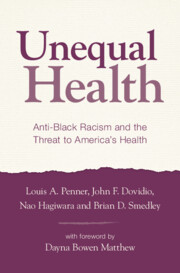Book contents
- Unequal Health
- Unequal Health
- Copyright page
- Dedication
- Endorsements
- Contents
- Figures
- Tables
- Foreword
- Prologue
- Acknowledgments
- Introduction
- Chapter 1 The Past Is Prologue
- Chapter 2 A Threat to the Common Good
- Chapter 3 “Two Americas”
- Chapter 4 Racism in American Medicine
- Chapter 5 Not Part of the Solution
- Chapter 6 A Dangerous Foot in the Door
- Chapter 7 Paths to a Solution
- Index
- References
Chapter 6 - A Dangerous Foot in the Door
The Impact of Race-Related Thoughts and Feelings on Healthcare Disparities
Published online by Cambridge University Press: 07 September 2023
- Unequal Health
- Unequal Health
- Copyright page
- Dedication
- Endorsements
- Contents
- Figures
- Tables
- Foreword
- Prologue
- Acknowledgments
- Introduction
- Chapter 1 The Past Is Prologue
- Chapter 2 A Threat to the Common Good
- Chapter 3 “Two Americas”
- Chapter 4 Racism in American Medicine
- Chapter 5 Not Part of the Solution
- Chapter 6 A Dangerous Foot in the Door
- Chapter 7 Paths to a Solution
- Index
- References
Summary
This chapter describes the role of individuals’ race-related thoughts and feelings in racial disparities in healthcare. Racial treatment disparities exist across a wide variety of medical settings and problems. Race-related thoughts and feelings – both implicit and explicit – play an important role in Black people receiving poorer healthcare. They affect the quality of communication between non-Black physicians and Black patients. Good physician–patient communication is critical to effective treatments; however, on average, communication is poorer in racially discordant (i.e., cross-race) medical interactions than racially concordant (i.e., same race) ones. Specific race-related thoughts and feelings, such as racial bias and medical mistrust also affect the quality of healthcare. Most physicians claim to be color blind when treating their patients but, in fact, physicians’ explicit and implicit racial bias negatively affect their perceptions of Black patients and how they act toward them. The behaviors of high implicit bias physicians can often have a negative impact on their Black patients. Black patients’ experiences with racial discrimination also affect race-related thoughts and feelings relevant to their medical care. Experiences with discrimination can result in greater medical mistrust, which makes people less likely to (1) experience positive outcomes from their healthcare and (2) engage in health-promoting behaviors.
Keywords
- Type
- Chapter
- Information
- Unequal HealthAnti-Black Racism and the Threat to America's Health, pp. 250 - 296Publisher: Cambridge University PressPrint publication year: 2023

